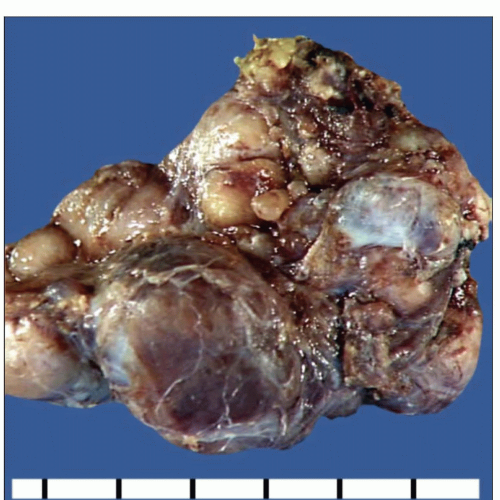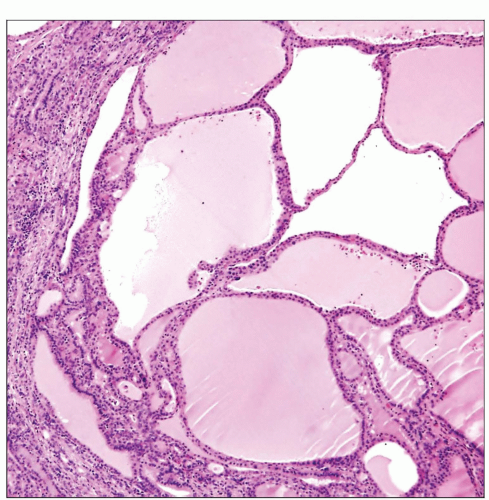Ectopic Thyroid Tumor
Key Facts
Clinical Issues
Anterior superior mediastinum; rarely in posterior mediastinum
Shortness of breath
Symptoms of hyperparathyroidism
May be asymptomatic and discovered incidentally on routine chest x-rays
Majority of lesions are cured by simple excision
Malignant tumors may recur and metastasize
Macroscopic Features
Generally well circumscribed, encapsulated, and multilobulated
Malignant neoplasms may be poorly circumscribed and infiltrate adjacent structures
Microscopic Pathology
Hyperplastic thyroid nodules are ill-defined, unencapsulated, and composed of normal follicular structures
May contain focal papillary structures, calcifications, and intraluminal follicular proliferations (Sanderson polsters)
Rarely, follicular or papillary carcinoma may arise from ectopic thyroid elements
Follicular carcinoma shows follicles with invasion of capsule and blood vessels
Papillary carcinoma is characterized by usual nuclear features of this tumor in thyroid
Medullary carcinoma, anaplastic carcinoma, and poorly differentiated (“insular”) carcinoma can also arise in mediastinum
 Gross appearance of ectopic mediastinal goiter shows a tan-brown, multinodular mass covered by a thin, shiny capsule, with confluence of multiple, soft nodules of varying sizes. |
TERMINOLOGY
Definitions
Proliferation of thyroid tissue originating from displaced or ectopically located elements in mediastinum
ETIOLOGY/PATHOGENESIS
Developmental Anomaly
May result from abnormal migration during embryogenesis
CLINICAL ISSUES
Epidemiology
Incidence
Develops in 5% of persons worldwide
Age
Adults
Increases in frequency with advancing age
Gender
More common in females (M:F = 1:3)
Site
Anterior superior mediastinum; rarely in posterior mediastinum
Presentation
Shortness of breath
Cough & dysphagia due to compression of esophagus
Dyspnea, wheezing, and stridor due to compression of trachea
Dysphonia may occur due to compression of recurrent laryngeal nerve
Often asymptomatic and discovered incidentally on routine chest x-rays
Most patients are mildly hypothyroid or euthyroid
Treatment
Surgical excision
Observation is recommended for small lesions or in elderly patients
Prognosis
Majority of lesions are cured by simple excision
Malignant tumors may recur and metastasize
In rare instances, histologically benign lesion can recur and invade local structures
IMAGE FINDINGS
General Features
Tracheal deviation at level of thoracic outlet
Involvement of superior mediastinum, with extension into neck
High attenuation due to natural iodine
Regions of low attenuation due to colloid cysts
Coarse calcifications in cyst walls in up to 75% of cases
Enhances strongly with IV contrast
I-123 and I-131 are diagnostic but often unnecessary
Best imaging tool is chest x-ray with confirmation by CT scan
MACROSCOPIC FEATURES




